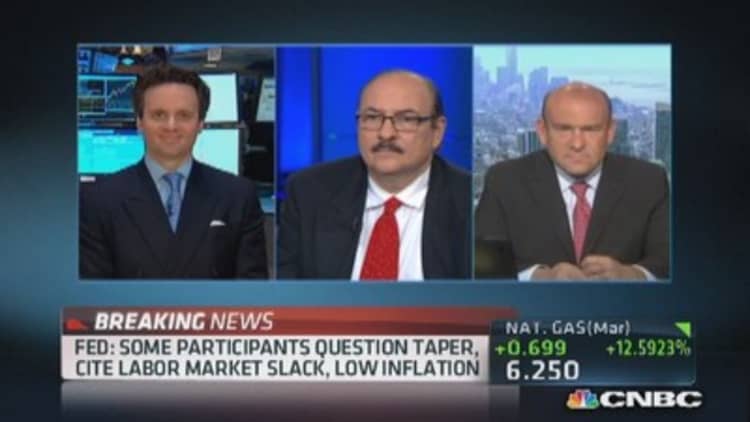
Federal Reserve officials had their most extensive discussion of raising rates in years, though the idea ultimately was dismissed, according to minutes from the most recent central bank meeting.
Fed officials also weighed whether it might be time to drop the notion that a decline to 6.5 percent unemployment rate, from its current 6.6 percent, would be enough to consider raising rates.
"Participants agreed that, with the unemployment rate approaching 6.5 percent, it would soon be appropriate for the Committee to change its forward guidance in order to provide information about its decisions regarding the federal funds rate after that threshold was crossed," the January minutes said.
At the same time, the minutes did note that "a few" members indicated "that it might be appropriate to increase the federal funds rate relatively soon."
(Read more: Cashin: Why 'the Fedis flying blind')
Those members, whose names were not disclosed, indicated that "before the middle of the year" would be an appropriate timeline to consider a rate hike.
The notion was discounted by other members who cited among other things "the lingering effects of the financial crisis" as reason not to change the rate structure.
"We obviously have hawks on the committee who have been talking about the possibility of raising rates for a while and in fact we have export and import prices that show when you take out the commodity components, that there is inflation accelerating," Joe LaVorgna, chief U.S. economist at Deutsche Bank, told CNBC.
In previous meetings, the Fed set 6.5 percent for the jobless number and 2.5 percent for inflation as the points when it would consider raising rates from near-zero current levels.
Officials at the central bank were willing to write off recent weak payrolls reports as due to weather and expected things to pick up in the months ahead. That could hasten the jobless rate decrease—particularly in light of the weak labor force participation rate—and push the Fed into monetary tightening at a level with which it is not comfortable.
(Read more: )
In taking a fairly upbeat economic view, they considered "appropriate" the idea that it could continue to unwind the monthly bond-buying program that has taken the Fed's balance sheet past $4.1 trillion. There seemed to be little appetite for delaying the tapering of purchases for another month.
The Fed Open Market Committee unanimously voted at the January meeting to reduce the pace of quantitative easing by another $10 billion to $65 billion a month.
In doing so, Fed officials have repeated said in public that cutting the program—"tapering," in market lingo—was not equivalent to tightening monetary policy.
Discussions at the meeting, in fact, indicated a willingness to drop both unemployment and inflation as rate triggers, instead opting for "risks to financial stability" or the Fed's Summary of Economic Projections as the key tools in determining policy.
—By CNBC's Jeff Cox. Follow him on Twitter @JeffCoxCNBCcom.


